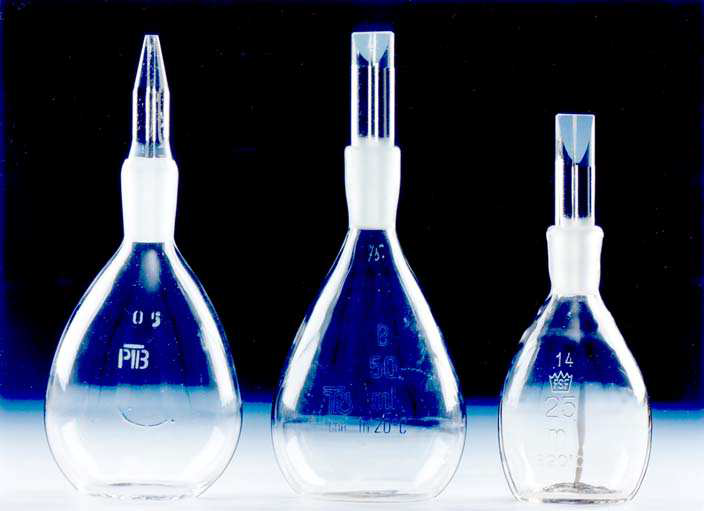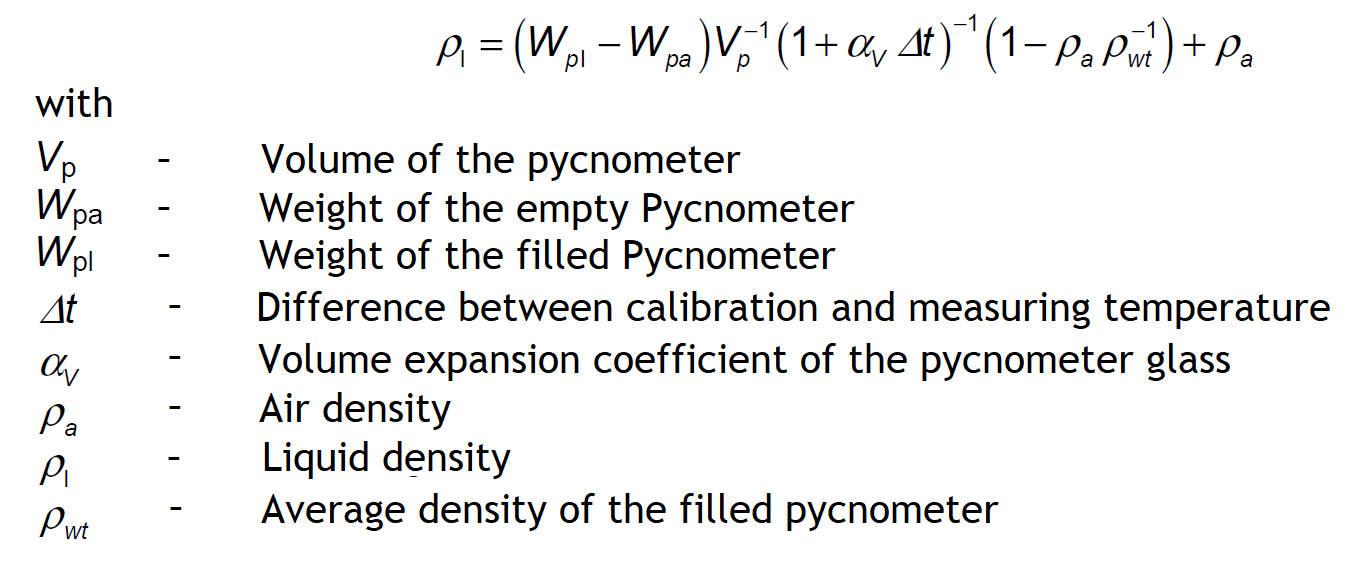Pycnometers are very practical and accurate measuring instruments for the density of liquids and thus also for the sugar or alcohol content:
 Our two calculators for this:
Our two calculators for this:
Pycnometer Alcohol Strength
Pycnometer Sugar Concentration
A pycnometer is actually simply a very constant and precisely fillable volume. You fill the flask with the liquid, put on the stopper and excess liquid escapes upwards through the capillary in the stopper, which is then wiped off. Then the pycnometer is weighed. The density is calculated from the weight of the filled and empty pycnometer and its internal volume. The difference in weight divided by the volume gives the density.
Despite this simple calculation, the accuracy is already higher than with conventional spindles or refractometers. However, our calculators for alcohol and sugar solutions include additional factors:
What quality should a pycnometer meet?
None in particular. If no borosilicate is used, but cheaper normal glass, this can be taken into account in the calculators. And if no volume is engraved, the volume can be measured with water. It is even better to determine the volume yourself. This is because inaccuracies in volume determination then theoretically mathematically cancel out inaccuracies in the actual measurements on alcohol or sugar solutions. For the volume determination we have the calculator Pyknometer Volume Determination. Cheap pycnometers in sizes up to 50ml are available for about 20€.
What quality should the balance have?
Nowadays, there are already quite cheap electronic precision balances that can display up to 50g or 100g three digits behind the decimal point. The 50g version for so 20€ and the 100g version so 25€. However, this resolution does not correspond to the accuracy of the balance. Nevertheless, very good measurements are possible with these balances for our purposes. The usually supplied calibration weight is of course not very accurate. But also here the same applies, as with the pycnometer: Errors due to an inaccurate calibration weight are mathematically compensated for by errors in the actual alcohol or sugar measurement.
However, it is important that the pycnometer fits the balance. We can recommend the following two combinations for our purposes:
- 25ml pycnometer and 50g precision balance
- 50ml pycnometer and 100g precision balance
As with measurements with spindles or refractometers, an accurate temperature measurement is also important here. And since with pycnometers the accuracy of the measurement is higher, the more you lose with an inaccurate temperature measurement. So you should invest something in a good temperature measurement. Since an accurate temperature measurement can perhaps also be used in the still, it is worth considering spending more money on it than on the pycnometer plus the precision balance.
Details on how to carry out the measurement:

Pycnometer Alcohol Strength
Pycnometer Sugar Concentration
A pycnometer is actually simply a very constant and precisely fillable volume. You fill the flask with the liquid, put on the stopper and excess liquid escapes upwards through the capillary in the stopper, which is then wiped off. Then the pycnometer is weighed. The density is calculated from the weight of the filled and empty pycnometer and its internal volume. The difference in weight divided by the volume gives the density.
Despite this simple calculation, the accuracy is already higher than with conventional spindles or refractometers. However, our calculators for alcohol and sugar solutions include additional factors:
- The calculations are temperature corrected.
- The density of the air in the empty pycnometer is subtracted.
- The volume expansion of the pycnometer, which depends on the temperature and glass type, is taken into account.
- The average density of the filled pycnometer is taken into account.
- A Thermometer Error can be entered.

What quality should a pycnometer meet?
None in particular. If no borosilicate is used, but cheaper normal glass, this can be taken into account in the calculators. And if no volume is engraved, the volume can be measured with water. It is even better to determine the volume yourself. This is because inaccuracies in volume determination then theoretically mathematically cancel out inaccuracies in the actual measurements on alcohol or sugar solutions. For the volume determination we have the calculator Pyknometer Volume Determination. Cheap pycnometers in sizes up to 50ml are available for about 20€.
What quality should the balance have?
Nowadays, there are already quite cheap electronic precision balances that can display up to 50g or 100g three digits behind the decimal point. The 50g version for so 20€ and the 100g version so 25€. However, this resolution does not correspond to the accuracy of the balance. Nevertheless, very good measurements are possible with these balances for our purposes. The usually supplied calibration weight is of course not very accurate. But also here the same applies, as with the pycnometer: Errors due to an inaccurate calibration weight are mathematically compensated for by errors in the actual alcohol or sugar measurement.
However, it is important that the pycnometer fits the balance. We can recommend the following two combinations for our purposes:
- 25ml pycnometer and 50g precision balance
- 50ml pycnometer and 100g precision balance
As with measurements with spindles or refractometers, an accurate temperature measurement is also important here. And since with pycnometers the accuracy of the measurement is higher, the more you lose with an inaccurate temperature measurement. So you should invest something in a good temperature measurement. Since an accurate temperature measurement can perhaps also be used in the still, it is worth considering spending more money on it than on the pycnometer plus the precision balance.
Details on how to carry out the measurement:
- Cheap electronic precision balances have the problem that they become electrostatically charged and the charge cannot be discharged through the plastic housing. This verifiably falsifies the measurement: If you bring your hand close to the plastic measuring plate from above, the measured value will drop somewhat, depending on the static charge, because the charge of the hand pulls the measuring plate up a little. It is therefore recommended to refrain from wiping the plastic housing before the measurement and to keep some distance to the balance during the measurement.
- The pycnometer and the liquid to be measured should be stored in the same place so that they have the same temperature. And the measurement should also done there so that the temperature does not change during the measurement.
- You should touch the pycnometer as little as possible. For example, make your fingers pointed. Firstly because of the heating and secondly because of the static charge.
- When filling the liquid, no air bubbles should remain in the pycnometer. In practice, however, this hardly ever happens anyway. And if they do, they can be easily stirred out during the temperature measurement.
- After a measurement of a sugar solution, the pycnometer must be rinsed thoroughly. It is not absolutely necessary after a measurement of an alcohol solution.
- The pycnometer stands empty and without stopper on a tissue.
- The liquid is poured almost to the brim using a small beaker.
- Now measure the temperature of the liquid. Because of the inertia of the thermometer, you should allow more than ten seconds for this.
- Now put on the stopper. Some liquid should come out at the edge of the flask and at the top through the capillary. If not, too little liquid has been filled in and the stopper should be removed again and some liquid added.
- Now dry the pycnometer with the tissue. Do not rub but let it soak up. Also the rim between the flask and stopper. But the drop that lies on the stopper should not yet be wiped away.
- Now place the pycnometer on the balance and only then remove the drop on the capillary with the tissue. The goal is that when you read the weight, the drop is gone but the capillary is still fully filled. If you see that the capillary is partially empty during the measurement, this amounts to about 0.8µl per mm. You can reduce the entered pycnometer volume by this amount. So, assuming it normally has exactly 50ml volume, it has 49.996ml volume with 5mm unfilled capillary.